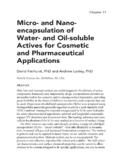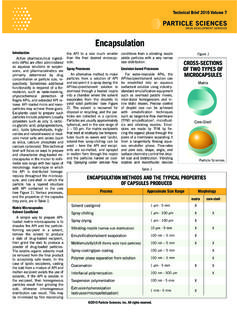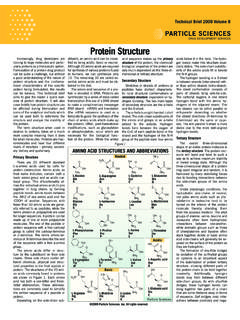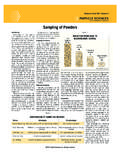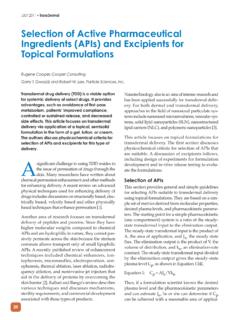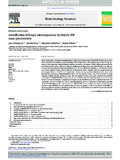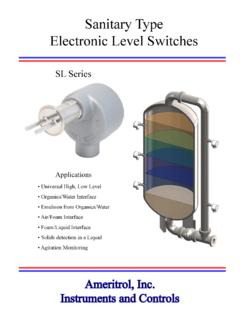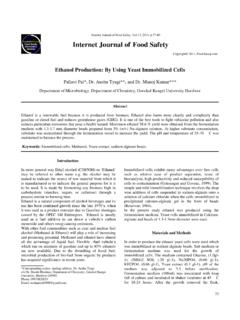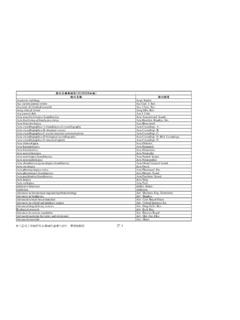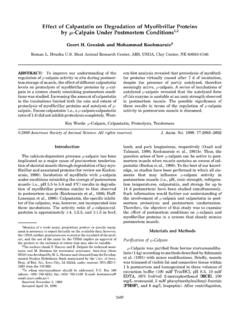Transcription of In Vitro Dissolution Testing for Solid Oral Dosage …
1 APPARATUS 2 Figure 1 Particle Sciences 2010 Particle Sciences, Inc. All rights drug substance and involves two steps: Dissolution and absorp-tion (or permeability). Understand-ing the multi-step Dissolution pro-cess is essential to proper in Vitro method development. Dissolution is the process of extracting the API out of the Dosage form Solid -state matrix into solution within the gastrointestinal tract. Absorption is the process of transporting the drug substance from the gastroin-testinal lumen into the systemic circulation. Dissolution Testing is an in vi-tro method that characterizes how an API is extracted out of a Solid Dosage form.
2 It can indicate the efficiency of in vivo Dissolution but does not provide any informa-tion on drug substance absorption. Pharmacokinetic data supplements and provides additional informa-tion regarding API absorption of the appropriate in Vitro conditions (media and hydro-dynamics) that simulate the in vivo conditions can lead to the genera-tion of successful IVIVC or at the very least, in Vitro -in vivo relations (IVIVR).3 Conditions that are op-timal for QC purposes may not be applicable for establishing IVIVC so it may be necessary to use two Dissolution tests to meet different objectives such as development needs or regulatory Method Parameters A logical, systematic approach taking into consideration both sci-entific and regulatory principles, should be followed when develop-ing a Dissolution method.
3 Table 1 lists common parameters and con-ditions that are evaluated during method A robust Dissolution method must be free of artifacts, yield low-to-moderate variability, have good profile shape and must be chal-lenged to pick up critical quality attributes. Once the medium and apparatus are selected, the meth-od should be further optimized for parameters such as agitation rate, ionic strength, and surfactant concentration, if applicable. The In Vitro Dissolution Testing for Solid Oral Dosage FormsIntroductionDissolution Testing is a require-ment for all Solid oral Dosage forms and is used in all phases of development for product release and stability testing1.
4 It is a key analytical test used for detect-ing physical changes in an active pharmaceutical ingredient (API) and in the formulated product. At early stages of development, in Vitro Dissolution Testing guides the optimization of drug release from formulations. Over the past 50 years, Dissolution Testing has also been employed as a quality control (QC) procedure, in R&D to detect the influence of critical manufacturing variables and in comparative studies for in Vitro -in vivo correlation (IVIVC).2 The FDA guidance on dissolu-tion Testing for immediate release Solid oral Dosage forms1 includes the use of the Biophar maceutics Classification System (BCS) guidelines for biorelevant dissolu-tion tests, which is based upon API solubility and According to the BCS guidelines, in Vitro dissolu tion Testing may be a useful tool to forecast the in vivo performance of drug products and potentially reduce the num-ber of bioavailabil ity/bioequiva-lence studies required.
5 The FDA guidance on scale-up and post-approval changes (SUPAC) for im-mediate release oral Dosage forms recommends the use of in Vitro Dissolution to justify post-approval Despite being readily-entrained in pharmaceutical and biotechnol-ogy industry, the basics of the dis-solution test are often misunder-stood. The test must be rugged and reproducible and highlight or discriminate significant changes in product specific Dissolution tech-nique employed is determined by the Dosage form characteristics and the intended route of admin-istration. For Solid Dosage forms, industry standard Dissolution test-ing methodologies are the United States Pharmacopoeia (USP) Ap-paratus 1 (basket) and the USP Apparatus 2 (paddle) (see Figure 1).
6 Immediate-release, modified-release and extended release tab-lets are usually tested in classical Dissolution baths with USP 2 pad-dles. Floating capsules and tab-lets generally use USP 1 baskets. Other Dissolution techniques and equipment include USP 3 (recip-rocating cylinders), USP 4 (flow-through-cell), USP 5 (paddle-over-disk), USP 6 (cylinder) and USP 7 (reciprocating holders).5 The development of a dissolu-tion procedure involves selecting the Dissolution media, apparatus type and hydrodynamics (agitation rate) appropriate for the product. This overview article will focus on the most commonplace (USP 1 and 2) Dissolution apparatus and present an overview of typical method parameters that should be considered during Dissolution most Dosage forms to be efficacious, the API(s) must be absorbed into the systemic circu-lation so that it can be transported to its site of activity.
7 This process contributes to the bioavailability of final method should discriminate between formulations yet possess sufficient reproducibility and ro-bustness. In terms of statistics, a relative standard deviation of <20% at early time points and <10% at later time points is , the percent dissolved API (up to 100%) vs. time is plot-ted. Dissolution profiles of Dosage forms with known formulation, manufacturing or bioavailability differences can aid in identifying a discriminatory set of media/hy-drodynamic conditions. Figure 2 illustrates a Dissolution plot at 50 rpm (tablet with increased release variability due to a method artifact known as coning), 75 rpm (tab-let showing proper release), and a mis-manufactured tablet at 75 rpm (showing slower and improp-er/incomplete release).
8 APIR eview of API properties (BCS-classification, pKa, stability, solu-bility as a function of pH/surfac-tant concentration, particle size, and polymorphism) that are likely to affect the in Vitro Dissolution be-havior should be evaluated as part of method development. Dosage FormThe key properties of the dos-age unit, including Dosage form type (tablet, capsule), expected number of potencies and desired release mechanism plus specific formulation information such as excipients, lubricants, disinte-grants, moisture content, surface coating and known stability is-sues (cross-linking, friability) are all important factors to consider.
9 Manufacturing variables such as lubrication blend time, compres-sion force, excipient/API addition order, drying parameters and coat-ing parameters are also critical to understanding API release differ-ences between first step is to screen formu-lations with aqueous-based media in the range of pH to at Technical Brief 2010 Volume 5the USP recommended ionic For APIs that exhibit low solubilities in aqueous me-dia throughout the pH range, the addition of surfactants is recom-mended. A medium resulting in a gradual increase of released drug up to 100% is preferred because it is more likely to detect differ-ences in formulation or processing parameters.
10 Visual ObservationsIt is imperative to visually ob-serve the behavior of the Dosage form throughout the Dissolution Testing run. Of primary concern is coning, which results in a cone-shaped mass of disintegrated, in-soluble solids at the bottom of the Apparatus 2 vessel. AnalysisAt set time points, aliquots of filtered medium are removed and analyzed for API content by HPLC or UV-Vis. During development, HPLC is most commonly used. It has the advantage of being able to separate the API from potential interferences from the formula-tion matrix or Dissolution medium and can detect API degradation. Furthermore, large variations in sample concentration can often be accommodated by adjusting injec-tion volume.
